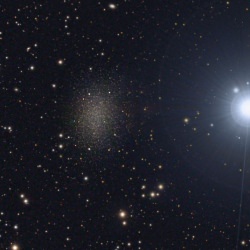
Leo 1 by Bernhard Hubl
Astronomers are beginning to see a pattern in what was previously viewed as the random distribution of galaxies tossed across the universe. Emerging is an understanding that the galaxies are distributed on the surface of huge bubbles whose interiors are void or contain material yet to be discovered. These bubbles are of various sizes but, in general, there are lots of them thus a helpful mental image of the universe’s organization may be something similar in appearance to soap suds. Where the edges of these bubbles meet, groups of galaxies tend to collect in bunches and this agrees with the observational evidence.
Our home Galaxy is called the Milky Way because the ancient Greeks rationalized its broad band of light arcing across the night sky was milk from the breast of the Queen of Gods, Hera. The Milky Way galaxy and thirty or more others which include M31, its two large satellites and M33 comprise what’s known as the Local Group. The Local Group of galaxies, in turn, interacts with four other nearby galaxy concentrations and it is thought that each of these clusters probably exchange members over some regular, but enormous, time scale.
Some of the members of the Local Group are actually satellites of our galaxy. Almost all of them are called dwarfs due to their small size and irregular shape. So far, twelve, maybe thirteen, have been identified, including the Large and Small Magellanic Clouds – more will likely be discovered. One of the most distant of these attendants, pictured here, is located about 900,000 light years from Earth and is called Leo 1.
Leo 1 was unknown until 1950 and was only visible through long exposure photographs until it was finally visually observed around 1990. The challenge with seeing or photgraphing this galaxy has less to do with its brightness than with the fact that it appears extremely close to the brightest star in the constellation Leo, which is called Regulus. Regulus is thousands of times more brilliant and the glare seen in optical instruments can wash out the presence of this small galaxy.
This remarkable photograph was produced by astronomer, Bernhard Hubl, at his imaging site in Schlierbach, Austria over a period of three nights during mid-March, 2006. This picture required over eight hours of exposure and was produced through a four inch aperture refractor with a 2 mega-pixel astronomical camera.
Do you have photos you’d like to share? Post them to the Universe Today astrophotography forum or email them, and we might feature one in Universe Today.
Written by R. Jay GaBany
